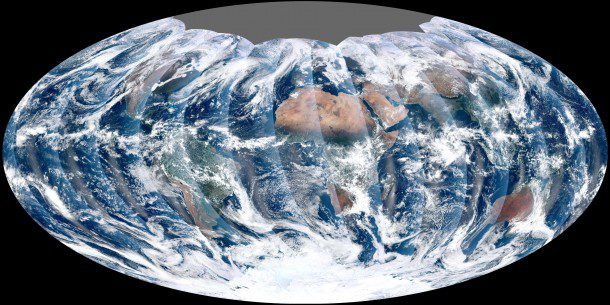
VIIRS, a scanning radiometer, collects visible and infrared imagery and radiometric measurements of the land, atmosphere, cryosphere and oceans. VIIRS measures 22 different wavelengths of light, but not all of the sensor's detectors are operating at peak performance yet. Those measuring thermal infrared light aren't yet cold enough to collect reliable measurements.
From its vantage 824 kilometers (512 miles) above Earth, the Visible Infrared Imager Radiometer Suite (VIIRS) on the NPOESS Preparatory Project (NPP) satellite gets a complete view of our planet every day. This image from Nov. 24, 2011, is the first complete global image from VIIRS.
The NPP satellite launched on Oct. 28, 2011, and VIIRS acquired its first measurements on Nov. 21. To date, the images are preliminary, used to gauge the health of the sensor as engineers continue to power it up for full operation.
Rising from the south and setting in the north on the daylight side of Earth, VIIRS images the surface in long wedges measuring 3,000 kilometers (1,900 miles) across. The swaths from each successive orbit overlap one another, so the sensor has a complete view of the globe at the end of the day. The Arctic is missing because it is too dark to view in visible light during the winter.
The NPP satellite was placed in a sun-synchronous orbit, a unique path that takes the satellite over the equator at the same local (ground) time in every orbit. This orbit allows the satellite to maintain the same angle between the Earth and the sun so that all images have similar lighting.
The consistent lighting is evident in the daily global image. Stripes of sunlight (sunglint) reflect off the ocean in the same place on the left side of every swath. The consistent angle is important, because it allows scientists to compare images from year to year without worrying about extreme changes in shadows and lighting.
Once VIIRS begins full operations, it will produce a range of measurements from ocean temperature to clouds to the locations of fires. These measurements will help extend the record from earlier sensors like the Moderate Resolution Imaging Spectroradiometer (MODIS). VIIRS is similar to MODIS, but it flies at a higher altitude to measure the whole planet without gaps. However, VIIRS sees Earth in less detail”375 meters per pixel, compared with 250 meters per pixel for MODIS.

